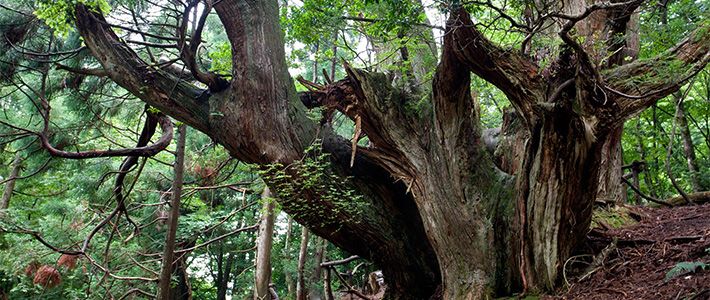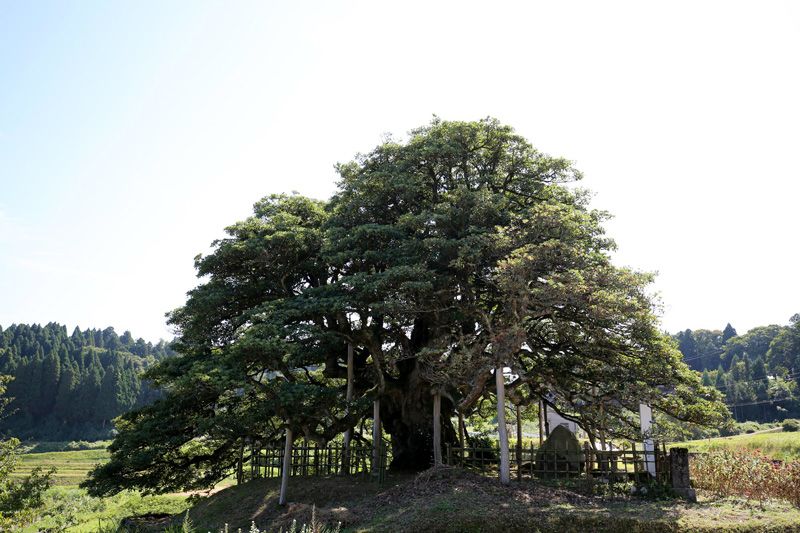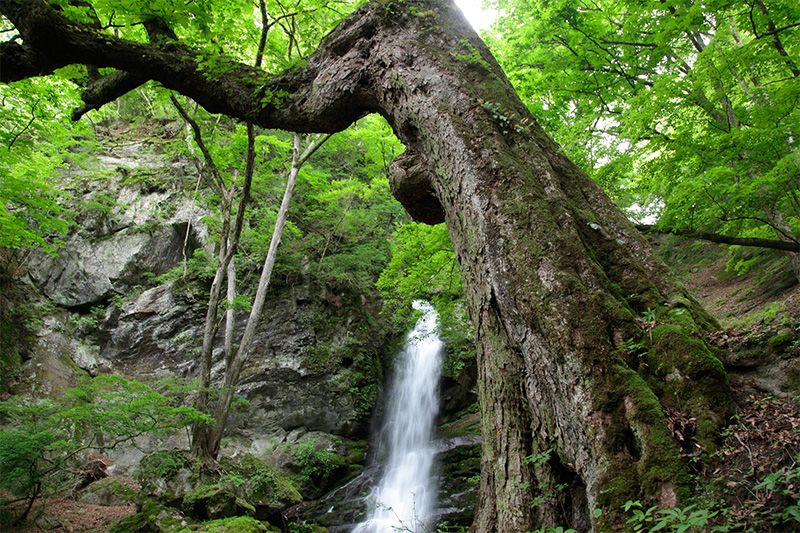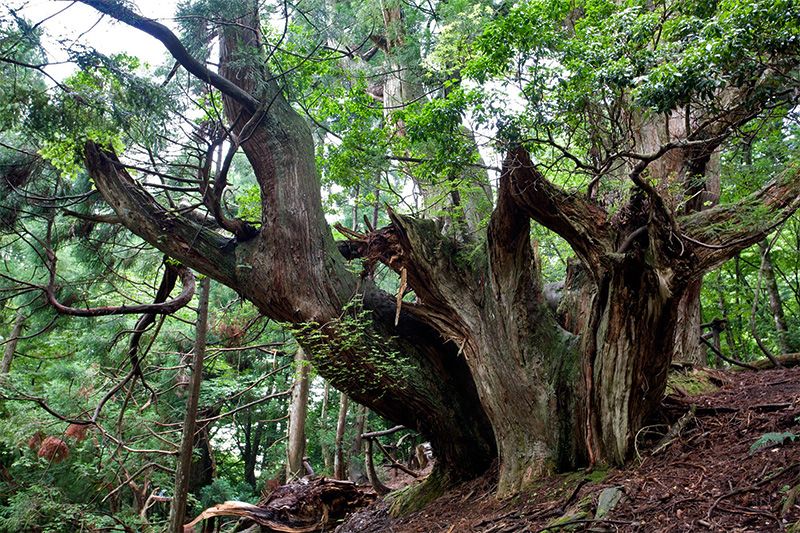
Japan’s Ancient Giants of the Forest
Deepening Summer: Ancient Trees in the Season of Heat
Guideto Japan
Culture- English
- 日本語
- 简体字
- 繁體字
- Français
- Español
- العربية
- Русский
Summer Kyoju
For trees, summer is a time of growth. But it is also an unforgiving season as the mercury rises. It is easy to believe the sizable dimensions of kyoju, or old-growth trees, makes these towering woodland giants impervious to the scorching sun. But they are in fact susceptible to even subtle environmental changes.
Like humans, trees must keep cool. The sheer girth of kyoju requires them to draw up great quantities of water to protect their forms from the shimmering noonday heat, releasing the moisture through their leaves in a process known as transpiration. With energy diverted toward this vital task, few species flower during the hottest months of the year. However, step into the shade of a kyoju and you will be rewarded with a welcome respite from the sun’s rays, as you are enveloped in a cooling veil of air.
Standing beneath the outstretched branches of an ancient tree reminds me of the carefree summer days of my childhood. Amid a cacophony of shrieking cicada my playmates and I would romp carefree around the grounds of a neighborhood Shintō shrine late into the day. Our only timekeeper was a sacred tree within the sanctuary’s confines, a towering kyoju that informed us with its lengthening afternoon shadow the hour to scurry home.
It is with these memories in my mind that I pay a summer visit to three old-growth sentinels.
The Grand Japanese Bay of Nagasaka (Toyama Prefecture)
Variety: Tabunoki (Japanese bay tree) (Machilus thunbergii)
Location: 598 Aza-maeda, Nagasaka, Himi, Toyama Prefecture, 935-0417
Trunk circumference: 7.02 m; height: 12 m; age: 500 years
Designated a prefectural natural monument
Size: ★★★
Vigor: ★★★★
Shape: ★★★★
Crown spread: ★★★★
Grandeur: ★★★
This august tabunoki, or Japanese bay tree, overlooks terraced rice fields in Nagasaka, a picturesque community in Toyama Prefecture a winding 10-kilometer drive northward of the fishing port town of Himi on the Noto Peninsula. The trunk juts a mere two meters upward, perhaps stunted by some ancient catastrophe, but gives way at its pinnacle to a splendid crown of arching limbs that bestow the plant with the aesthetic balance of a carefully groomed bonsai.
Like their distant cousin the camphor, Japanese bay trees thrive in temperate climates and show a particular fondness for coastal areas, which is where many of Japan’s largest specimens are found. In fact, the trees are so suited to seaside environs that stands now flourish in soil heavily salinized by the tsunami that ravished northeast Japan in March 2011, slowly returning desolated regions to lush greenness.
The Nagasaka bay tree, in spite of the sizable hollow in its trunk, presents a lively, vigorous form. Its branches spread broadly outward in a dynamic display of its vitality, and several stretch down the sculpted hillside beyond the base of the plant.
The tree is spectacular on its own, but when viewed amid the majestic tiered rice fields, among the 100 most beautiful in Japan, that stretch along the narrow valley it makes a truly stunning scene.
The Great Japanese Horse Chestnut of Fudōtaki Falls (Saitama Prefecture)
Variety: Tochinoki (Japanese horse chestnut) (Aesculus turbinata)
Location: Ōtaki-tochimoto, Chichibu, Saitama Prefecture, 369-1901
Trunk circumference: 6.5 m; height: 25 m; age: 500 years
Size: ★★★
Vigor: ★★★★★
Shape: ★★★★
Crown spread: ★★★★
Grandeur: ★★★★
The rugged mountains of Chichibu in western Saitama Prefecture are home to a number of famous waterfalls, one of the most renowned being Fudōtaki. The cascading waters of the 50-meter, three-tiered chute are a spectacular sight. But standing beside the falls like a herald is an equally impressive, albeit less celebrated—signboards fail to mention it altogether—natural wonder, an ancient Japanese horse chestnut, or tochinoki.
To reach the site hikers must venture off the old highway and follow a winding path through thick forest and steep mountainous terrain. From the trailhead the track dips to a narrow suspension bridge spanning the bubbling headwaters of the Arakawa River before climbing sharply to a ridge that after a brisk 20-minute hike opens to reveal the impressive waterfall and ancient, moss-covered tree. Horse chestnut and other water-loving species such as the katsura are commonly spotted near streams and rivers. But the grand Japanese horse chestnut and Fudōtaki are a matchless pair that create a moving scene of unprecedented beauty more than equal the exertion needed to see it.
The roots of the horse chestnut reach across the same rockface traversed by the falls, supporting the tree and giving a sense that the wooden giant is kneeling in respect before Fudōtaki. It is miraculous how the plant has come unscathed through the centuries in such a precarious pose. Visitors, if they so wish, can easily spend the whole day pondering this question as they let the cool splashing of the falls chase the summer heat away.
The Ancient Cedars of Shimokuroda (Kyoto Prefecture)
Variety: Sugi (Japanese cedar) (Cryptomeria japonica)
Location: Keihokukatanami, Ukyō Ward, Kyoto, Kyoto Prefecture, 601-0401
Trunk circumference: 15.2 m; height: 30 m; age: 800 years
Size: ★★★★★
Vigor: ★★★
Shape: ★★★★★
Crown spread: ★★
Grandeur: ★★★★★
People began tending the cedar forests around the upper waters of the Katanami River in the northwest mountains of Kyoto around the Heian period (794–1185). The trees provided timbers to build the newly established capital, including portions of the imperial palace.
Among the wood’s straight, uniform stands are ancient Japanese cedars whose squat, knotted trunks support skewed limbs, lending a distinct ambiance to the forest landscape. These candelabrum-shaped trees are the result of a clever cultivation style known as fukujō-daisugi whereby single plants were made to produce timber on an ongoing basis for centuries. Successive generations of woodcutters harvested mature lumber and promoted new shoots, slowly sculpting the cedars into peculiar forms.
From the early Muromachi period (1333–1568) onward, however, the trees were gradually abandoned as building methods changed and demand for lumber fell. Freed from their burden as daisugi, the cedars have over the subsequent centuries grown unencumbered. Stands of the aged trees—there are said to be more than 250 specimens—dot ridges across the Hanase and Keihoku regions in Kyoto’s rustic northern hills. Their enormous trunks, ranging from 3 meters to as much as 15 meters around, and contorted limbs now draw visitors who come to pay respect to these timeless giants of the forest. The plants lend a sense of otherworldliness to the woods, but also offer visitors a hint of the demands of the ancient capital in its early, booming days.
The forest is designated as a prefectural natural conservation area. Its enchanted landscape is crisscrossed with hiking paths and there are also guided tours exploring the woodland’s denser portions. The roughly three hours needed to walk the entire area is a richly rewarding endeavor both bodily and spiritually.
(Originally published in Japanese on July 22, 2016. Photos and text by Takahashi Hiroshi.)


